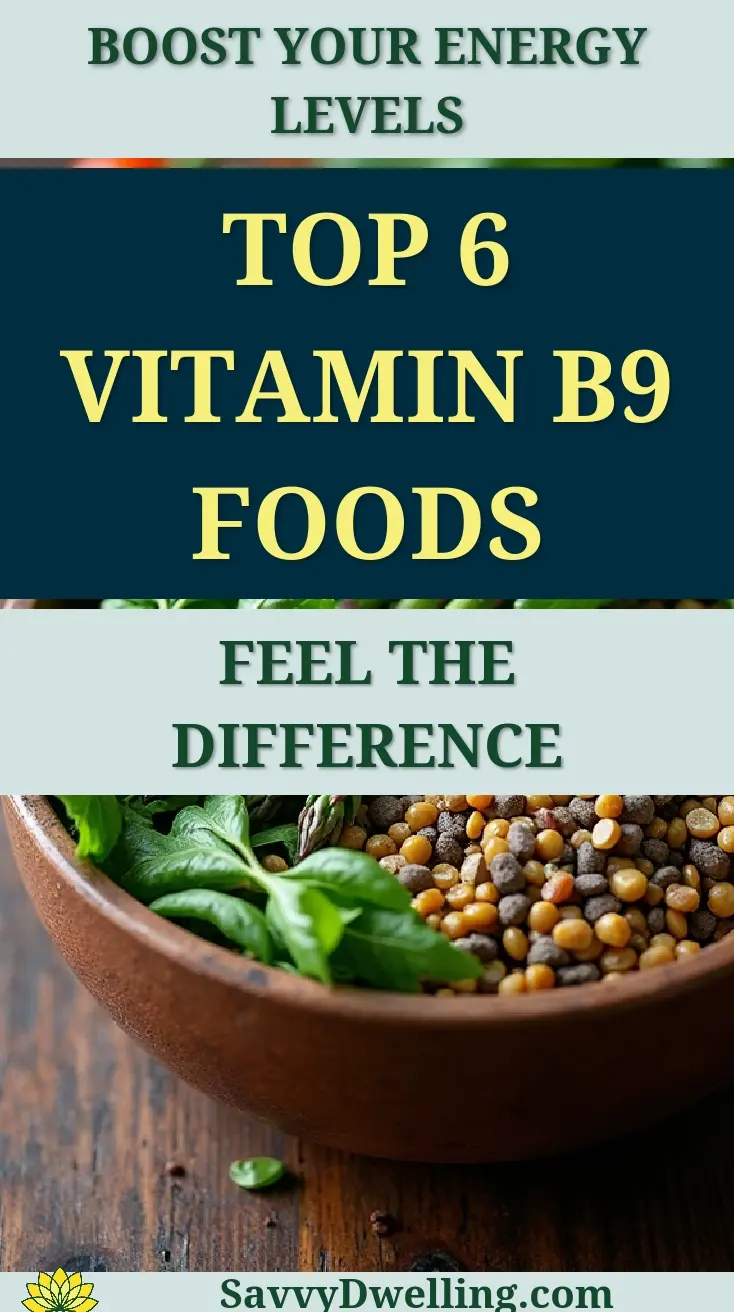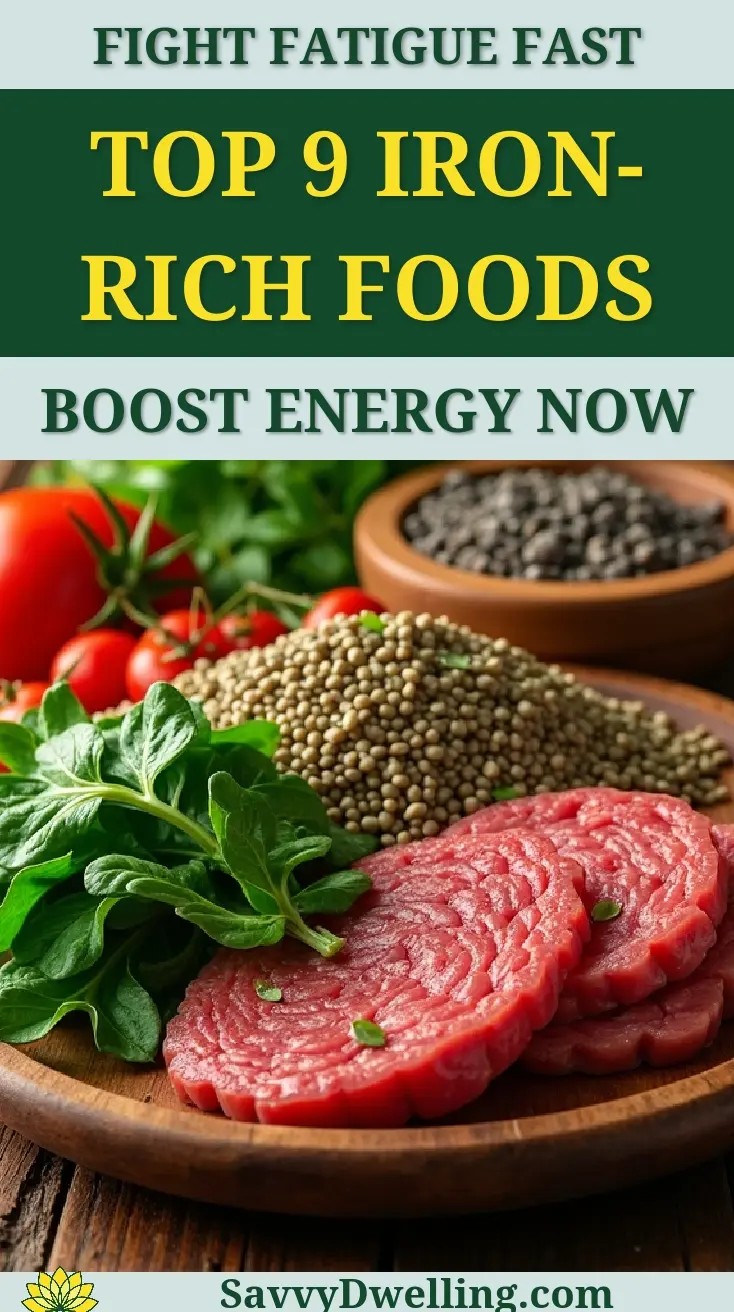10 Surprising Foods That Are High in Sugar: Hidden Sources Sabotaging Your Health Goals
Working hard to cut back on sugar, yet still feeling sluggish or struggling with cravings? Many foods marketed as healthy choices contain shocking amounts of hidden sugar that can derail your wellness efforts without you even realizing it. You’re not failing—you’re simply navigating a food system designed to disguise sweeteners in everyday staples.
This guide reveals the ten most deceptive high-sugar foods hiding in your kitchen and provides practical swaps that support your health goals. We’ve spent years researching food labels and ingredient lists to bring you clear, actionable strategies that make sugar-conscious eating simple and sustainable.
Contents
- At a Glance: The Best Solutions
- 1. Flavored Yogurt: The Breakfast Deceiver
- 2. Granola: Nature’s Candy in Disguise
- 3. Dried Fruit: Concentrated Sugar Bombs
- 4. Pasta and Marinara Sauce: The Savory Sugar Trap
- 5. Protein and Energy Bars: Fitness Food or Candy Bar?
- 6. Salad Dressings: The Healthy Meal Saboteur
- 7. Condiments and Sauces: Small Portions, Big Sugar Impact
- 8. Breakfast Cereals: Even the “Healthy” Ones
- 9. Nut Butters: When Healthy Fats Meet Added Sugars
- 10. Canned Soups: Comfort Food Sugar Surprise
- The Science Made Simple: Why Food Companies Add Hidden Sugars
- 5 Habits to Keep Hidden Sugars From Sabotaging Your Health Goals
- Frequently Asked Questions
- Final Words
- Additional Resources for You:
At a Glance: The Best Solutions
| Surprising High-Sugar Food | Sugar Content (per serving) | Smart Swap Alternative | Why It’s Surprising |
|---|---|---|---|
| Flavored Yogurt | 15-20g | Plain Greek yogurt + fresh berries | Marketed as healthy breakfast |
| Granola | 12-16g per ½ cup | Homemade oat mix with nuts | Perceived as natural and wholesome |
| Dried Fruit | 20-25g per ¼ cup | Fresh fruit or unsweetened versions | Concentrated natural sugars |
| Pasta Sauce | 6-12g per ½ cup | Fresh tomato-based sauce | Savory food with added sweeteners |
| Protein Bars | 10-25g | Nuts and seeds mix | Fitness-focused marketing |
1. Flavored Yogurt: The Breakfast Deceiver
Why This Healthy Food Hides So Much Sugar
Flavored yogurts-especially those labeled “fruit-on-the-bottom” or “low-fat”-often contain more sugar than a serving of dessert. Manufacturers add sugar to compensate for flavor lost during fat removal and to boost palatability. Even “organic” or “all-natural” versions frequently rely on fruit concentrates, cane sugar, or honey to sweeten the mix, turning a protein-rich breakfast staple into one of the most common hidden sugar foods.
Sugar Content Breakdown by Brand
| Brand (6 oz serving) | Added Sugar (grams) |
|---|---|
| Yoplait Original Strawberry | 18g |
| Dannon Fruit on the Bottom | 15g |
| Chobani Simply 100 | 8g |
| Stonyfield Organic Smooth & Creamy | 13g |
| Plain Greek Yogurt (for comparison) | 4–6g (naturally occurring lactose only) |
Smart Shopping Tips for Lower-sugar Options
- Pick plain Greek or Icelandic yogurt-they’re higher in protein and lower in sugar by default.
- Add your own sweetness: stir in fresh berries, a sprinkle of cinnamon, or a few drops of vanilla extract.
- Check the ingredient list-avoid anything with sugar, cane juice, fruit concentrate, or syrup in the top three ingredients.
- Compare labels: choose yogurts with ≤8g of total sugar per serving to stay in a healthier range.
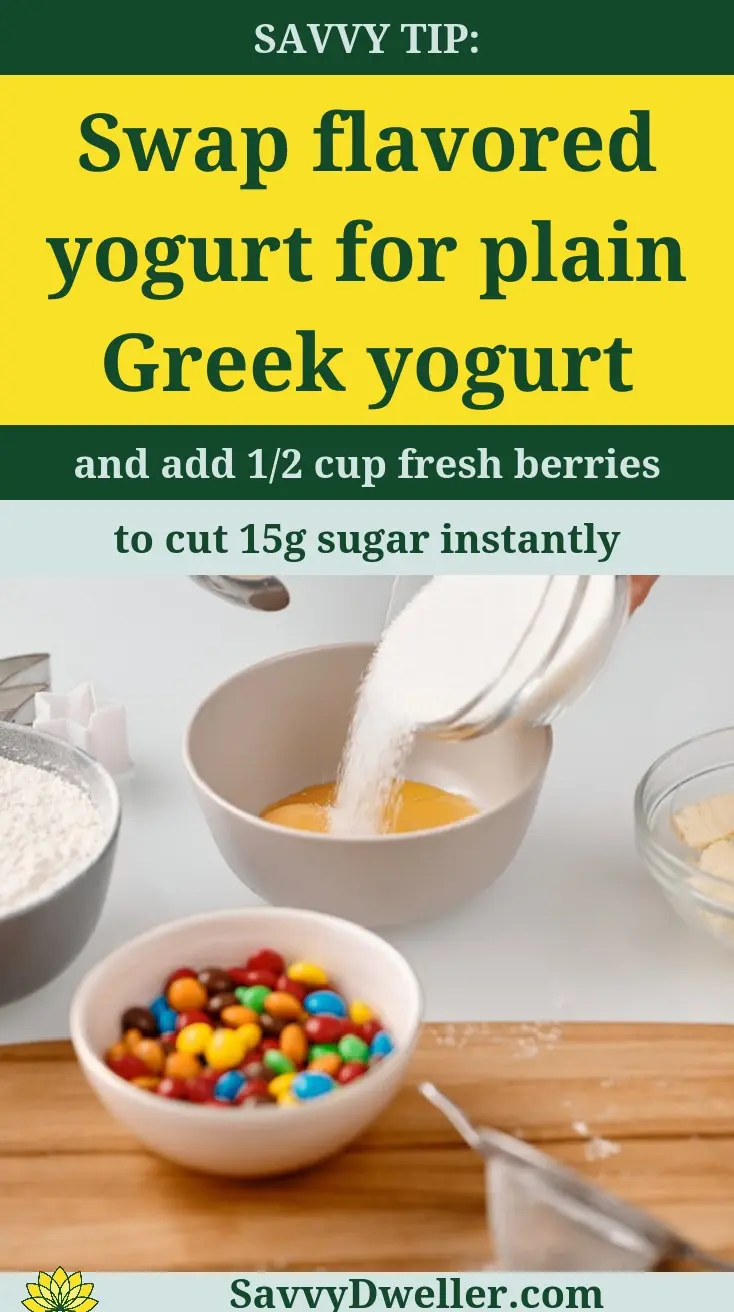
2. Granola: Nature’s Candy in Disguise
How “Healthy” Clusters Pack Hidden Sweeteners
Granola is often praised for its oats, nuts, and seeds-but what’s rarely mentioned is the syrupy glaze that binds it all together. Many commercial granolas are drenched in honey, brown rice syrup, or coconut sugar, making them one of the most deceptively high sugar items in the breakfast aisle. A half-cup serving can easily contain 12–16g of sugar, rivaling some snack bars in sweetness.
Ingredient Red Flags to Spot on Labels
- Brown rice syrup
- Agave nectar
- Evaporated cane juice
- Fruit juice concentrate
- “Crunchy clusters” or “lightly sweetened” claims (marketing terms that often hide high sugar content)
DIY Alternatives That Support Your Wellness Goals
- Start with old-fashioned rolled oats as your base.
- Add raw nuts (almonds, walnuts) and unsweetened coconut flakes for crunch.
- Use a minimal amount of pure maple syrup or mashed banana-no more than 1–2 tablespoons per 2 cups of oats.
- Bake at 300°F (150°C) for 20–25 minutes, stirring halfway, until golden and crisp.
- Store in an airtight container and use within two weeks to maintain freshness without preservatives.
Also See: What to Eat on a Keto Diet: A Beginner’s Food List
3. Dried Fruit: Concentrated Sugar Bombs
The Dehydration Effect on Natural Sugars
When fruit loses its water content during drying, its natural sugars become far more concentrated. That means a small handful of raisins or dried mango can deliver the sugar of several whole pieces of fresh fruit. While dried fruit contains fiber and nutrients, its dense sugar load-often 20–25g per ¼ cup-makes it one of the surprisingly high sugar foods people overlook when managing intake.
Most Problematic Dried Fruits to Limit
- Raisins (25g sugar per ¼ cup)
- Dried cranberries (often sweetened with added sugar-24g per ¼ cup)
- Dried mango (23g sugar per ¼ cup)
- Dried pineapple (20g+ sugar, especially if sulfured or candied)
Portion Control Strategies That Actually Work
- Pre-portion servings into small snack bags-aim for 1–2 tablespoons, not a full handful.
- Prioritize unsweetened versions: look for “no sugar added” on the label.
- Pair dried fruit with protein or fat (like a few almonds or a slice of cheese) to slow sugar absorption.
- Use it as a garnish, not a main snack-add a few pieces to oatmeal or salads for flavor, not bulk.
4. Pasta and Marinara Sauce: The Savory Sugar Trap
Why Manufacturers Add Sugar to Tomato Products
Tomatoes are naturally acidic, and food producers often add sugar to balance that tartness-a trick that makes marinara sauce taste smoother and more “palatable” to the average consumer. This practice turns a simple, savory staple into one of many surprising foods high in sugar. Even organic or “all-natural” brands may include cane sugar, beet syrup, or fruit concentrate to mask acidity without listing it as an artificial flavor.
Reading Labels to Identify Hidden Sweeteners
Don’t be fooled by front-label claims like “no high-fructose corn syrup” or “made with real tomatoes.” Sugar hides under more than 60 different names. When checking pasta sauce labels, watch for these common aliases for added sugar:
- Cane juice
- Tomato paste concentrate (often sweetened)
- Fruit puree or concentrate
- Agave nectar
- Maltodextrin (a processed carb that acts like sugar)
Aim for sauces with 4 grams of sugar or less per ½-cup serving-and ideally zero added sugars. If “sugar” appears in the first three ingredients, it’s likely a high-sugar item.
Simple Homemade Sauce Alternatives
Making your own marinara takes less time than you think and eliminates hidden sugars entirely. Here’s how:
- Heat 2 tablespoons of olive oil in a saucepan over medium heat.
- Add 3 minced garlic cloves and sauté until fragrant (about 1 minute).
- Pour in one 28-ounce can of crushed tomatoes (no salt or sugar added).
- Stir in 1 teaspoon dried oregano, ½ teaspoon red pepper flakes (optional), and a pinch of salt.
- Simmer uncovered for 15–20 minutes, stirring occasionally, until thickened.
This version gives you full control over ingredients and avoids the hidden sugar content in food that masquerades as a healthy choice.
5. Protein and Energy Bars: Fitness Food or Candy Bar?
How Marketing Masks High Sugar Content
With labels boasting “high protein,” “gluten-free,” or “packed with superfoods,” many protein and energy bars look like the ultimate on-the-go health food. But behind the wellness branding, these can be among the most deceiving unexpected foods that are high in sugar. Some contain as much sugar as a candy bar-complete with caramel, chocolate chips, and syrups-yet charge a premium price under the guise of performance nutrition. For those managing diabetes, choosing the right snacks is crucial to maintain stable blood sugar. Opting for foods that are low in sugar and high in fiber can help keep glucose levels steady.
Ingredient Analysis: What to Look for
Flip the bar over and scan the ingredients list. If you see any of the following in the first five items, it’s likely more dessert than fuel:
- Brown rice syrup
- Chicory root fiber (often paired with added sugars)
- Yacon syrup or monk fruit blends (sometimes masking other sweeteners)
- “Natural flavors” alongside fruit concentrates
- Multiple forms of sugar listed separately (to avoid it being the #1 ingredient)
Choose bars with fewer than 5 grams of added sugar and at least 5 grams of fiber to help slow sugar absorption. Also, prioritize whole-food ingredients like nuts, seeds, and unsweetened dried fruit.
Whole Food Alternatives for Energy Support
Instead of relying on processed bars full of hidden sugars in foods, try these whole food combos for lasting energy: Fueling your body with natural foods can provide a steady source of energy throughout the day. Incorporating fruits, nuts, and whole grains into your diet are some of the best foods for a natural energy boost.
- Apple slices with 2 tablespoons of unsweetened almond butter.
- A small handful of raw walnuts and a few dark chocolate chips (70% cacao or higher).
- Hard-boiled egg with a sprinkle of sea salt and a few cucumber slices.
- Chia pudding made with unsweetened almond milk, chia seeds, and a dash of cinnamon.
These options support steady energy without the blood sugar spikes linked to sugary foods.
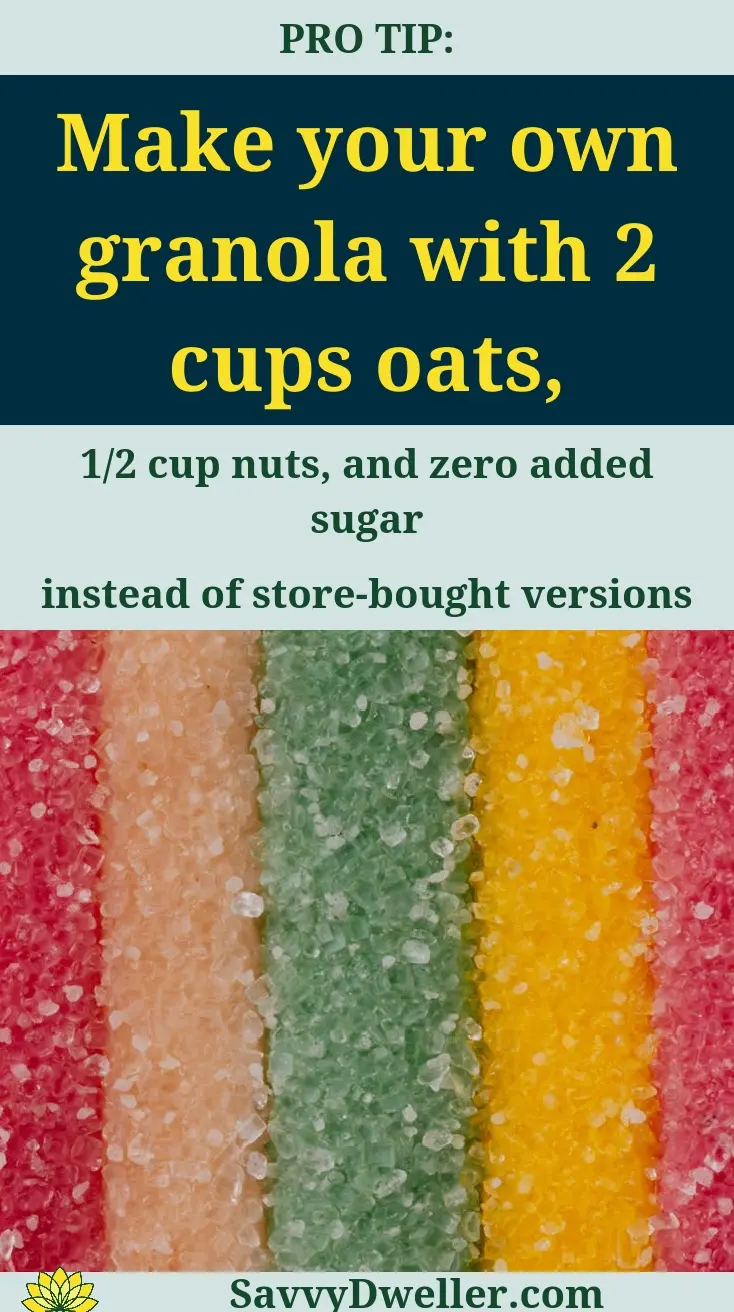
6. Salad Dressings: The Healthy Meal Saboteur
Common Dressings With Shocking Sugar Levels
That bottle of fat-free ranch or honey-lime vinaigrette might be pouring more sugar onto your greens than you realize. Many bottled dressings-especially creamy and fruity varieties-are unexpected foods high in sugar, often containing 3–8 grams per 2-tablespoon serving. Popular offenders include raspberry vinaigrette, Thai peanut, and even “light” Caesar dressings, which use sugar to compensate for removed fat.
Oil and Vinegar: Your Sugar-free Solution
Plain extra-virgin olive oil and vinegar (like balsamic, red wine, or apple cider) contain zero added sugar and let the natural flavors of your salad shine. Using just these two staples is the easiest way to avoid hidden sugar in foods while boosting healthy fat intake. Including healthy fats in your diet is essential for overall health. Plus, the fat helps your body absorb fat-soluble vitamins from leafy greens like A, D, E, and K.
Quick Homemade Dressing Recipes
Whip up a fresh, sugar-free dressing in under 2 minutes with these foolproof ratios:
- Lemon-Herb: Whisk 3 tbsp olive oil, 1 tbsp fresh lemon juice, 1 minced garlic clove, ½ tsp Dijon mustard, and a pinch of dried thyme.
- Balsamic Basic: Combine 2 tbsp balsamic vinegar (check label for no added sugar), 3 tbsp olive oil, and a pinch of sea salt.
- Creamy Avocado: Blend ½ ripe avocado, 2 tbsp lime juice, 1 tbsp water, 1 tsp olive oil, and a dash of cumin until smooth.
Store in a glass jar for up to 5 days. These simple swaps protect your healthy meal from becoming a hidden source of sugar.
7. Condiments and Sauces: Small Portions, Big Sugar Impact
That dollop of ketchup or drizzle of BBQ sauce might seem harmless, but these everyday condiments are among the most common surprising foods with sugar. Even a tablespoon can contain 3–4 grams of added sugar, which adds up fast when you’re not paying attention.
Ketchup, BBQ Sauce, and Sweet Relish Breakdown
Ketchup often contains high-fructose corn syrup or sugar as the second ingredient-right after tomatoes. A single tablespoon can pack 4 grams of sugar. BBQ sauces are even more deceptive, with some brands delivering 10–15 grams per 2-tablespoon serving. Sweet relish, commonly used on hot dogs or burgers, can contain up to 5 grams of sugar per tablespoon.
Asian Sauces That Pack Hidden Sweeteners
Teriyaki, hoisin, oyster sauce, and even some soy sauces often include added sugar to balance saltiness and enhance flavor. Teriyaki sauce, for example, can have 8–9 grams of sugar in just two tablespoons. These are classic examples of hidden sugar in foods that masquerade as savory ingredients.
Low-sugar Condiment Swaps for Every Meal
Swap out sugary staples with cleaner alternatives that still deliver bold flavor without the sugar crash:
- Use mustard (most yellow or Dijon varieties have 0g sugar) instead of ketchup.
- Make your own BBQ sauce with tomato paste, apple cider vinegar, smoked paprika, and a touch of molasses (optional).
- Choose dill relish over sweet relish-it’s typically sugar-free.
- Opt for coconut aminos instead of hoisin or teriyaki for a naturally low-sugar umami boost.
8. Breakfast Cereals: Even the “Healthy” Ones
Many breakfast cereals-even those labeled “whole grain,” “fiber-rich,” or “heart-healthy”-are loaded with added sugars. These products are among the most misleading entries on the list of surprisingly high sugar foods, especially when marketed to kids and health-conscious adults.
How Whole Grain Claims Mask Sugar Content
Brands often highlight whole grains or added fiber to imply nutritional value, while burying sugar in the ingredient list under names like cane syrup, brown rice syrup, or malt flavoring. A cereal can be “whole grain” and still contain 10+ grams of sugar per serving-making it more dessert than breakfast.
Serving Size Reality Check
Manufacturers often list nutrition facts for unrealistically small portions (like ¾ cup), even though most people pour 1½ to 2 cups. That “8g sugar” on the label can easily become 16–20g in a real-world bowl-turning your morning meal into a sugar spike.
Better Morning Options to Support Steady Energy
Choose breakfasts that provide lasting energy without blood sugar swings:
- Pick plain rolled oats and add cinnamon, chia seeds, and a few fresh berries.
- Go for unsweetened muesli instead of granola-it’s typically just grains, nuts, and dried fruit (in moderation).
- Make a veggie-packed omelet or scrambled tofu for a protein-rich, sugar-free start.
- If you must eat cereal, choose one with ≤3g of sugar per serving and check that sugar isn’t in the top three ingredients.
9. Nut Butters: When Healthy Fats Meet Added Sugars
Nut butters are praised for their healthy fats and protein, but many commercial jars hide surprising amounts of added sugar. This makes them a classic example of unexpected foods that are high in sugar-especially when labeled as “creamy” or “honey-roasted.” Incorporating nuts such as walnuts can offer a more nutritious alternative. They provide numerous health benefits, including heart health support and anti-inflammatory properties.
Natural Vs. Commercial Nut Butter Differences
True natural nut butter contains just one or two ingredients: nuts (and sometimes salt). In contrast, conventional brands often add sugar, palm oil, and hydrogenated oils for texture and shelf stability. A typical store-bought peanut butter may contain 2–3 grams of sugar per tablespoon-meaning a two-tablespoon serving equals a teaspoon of added sugar.
Reading Labels for Pure Nut Products
To avoid hidden sugars, scan the ingredient list carefully:
- Acceptable ingredients: Peanuts, almonds, cashews, salt.
- Red flags: Sugar, corn syrup, molasses, “natural flavors,” honey (unless you’re okay with minimal natural sweeteners).
If the label lists more than three ingredients, it’s likely not a pure product.
Making Your Own Sugar-free Versions
Creating your own nut butter at home ensures zero added sugar and full control over quality:
- Roast 2 cups of raw nuts (peanuts, almonds, or cashews) at 350°F for 10–12 minutes until fragrant.
- Let them cool slightly, then blend in a food processor for 8–12 minutes, scraping down the sides as needed.
- Add a pinch of sea salt (optional) once the mixture turns creamy-no oil or sweetener needed.
- Store in a glass jar for up to 3 weeks. The natural oils may separate; just stir before use.
This simple method gives you a clean, nutrient-dense spread that supports your wellness goals without sneaking in hidden sugars in foods.
10. Canned Soups: Comfort Food Sugar Surprise
Why Soup Manufacturers Add Sweeteners
Many canned soups-even those labeled “savory” or “hearty”-contain added sugars to balance acidity, enhance flavor, and improve mouthfeel. Food makers rely on hidden sugars to make shelf-stable products more appealing without raising red flags on the ingredient list. This practice turns a comforting bowl of soup into one of the unexpected foods that are high in sugar.
Tomato-based Soups: The Biggest Offenders
Tomato soup, vegetable medleys, and creamy bisques often lead the pack among surprisingly high sugar foods. A single serving (about 1 cup) can harbor 8–12 grams of added sugar-sometimes more than a chocolate chip cookie. Acidic tomatoes naturally prompt manufacturers to add sweeteners to mellow the tang, making these soups prime examples of hidden sugar in foods.
Homemade Soup Solutions for Better Health
Taking control of your broth starts with swapping canned versions for homemade. It’s easier than you think:
- Sauté onions, garlic, and celery in olive oil as your flavor base-no sugar needed.
- Use no-salt-added canned tomatoes or fresh to avoid hidden sweeteners and excess sodium.
- Add herbs like basil, thyme, or oregano early to build depth without sweetness.
- Blend in cooked white beans or cauliflower for creaminess instead of relying on dairy-sugar combos.
- Batch-cook and freeze in portions so you always have a clean, sugar-free alternative ready.
The Science Made Simple: Why Food Companies Add Hidden Sugars
Palatability and Addiction Factors
Food scientists know that sugar triggers dopamine release, creating a mild pleasure response that encourages repeat purchases. Even in savory items like soups or sauces, small amounts of added sugar make flavors more rounded and craveable-turning everyday meals into stealthy sources of hidden sugar. This tactic is especially common in foods with hidden sugar marketed as convenient or healthy.
Preservation and Shelf-life Benefits
Sugar isn’t just about taste-it’s a functional ingredient. It binds water, slows microbial growth, and stabilizes texture in processed goods. In canned soups and sauces, sugar helps maintain consistency and color over months on the shelf, making it a go-to for manufacturers prioritizing longevity over clean labels.
Cost-cutting Measures That Impact Your Health
Using high-fructose corn syrup or cane sugar is often cheaper than sourcing high-quality vegetables or natural flavor enhancers. By replacing real ingredients with sweet fillers, companies reduce production costs while masking bland or over-processed bases. Unfortunately, this trade-off shows up in your pantry as one of the most common hidden sugar foods you didn’t expect.
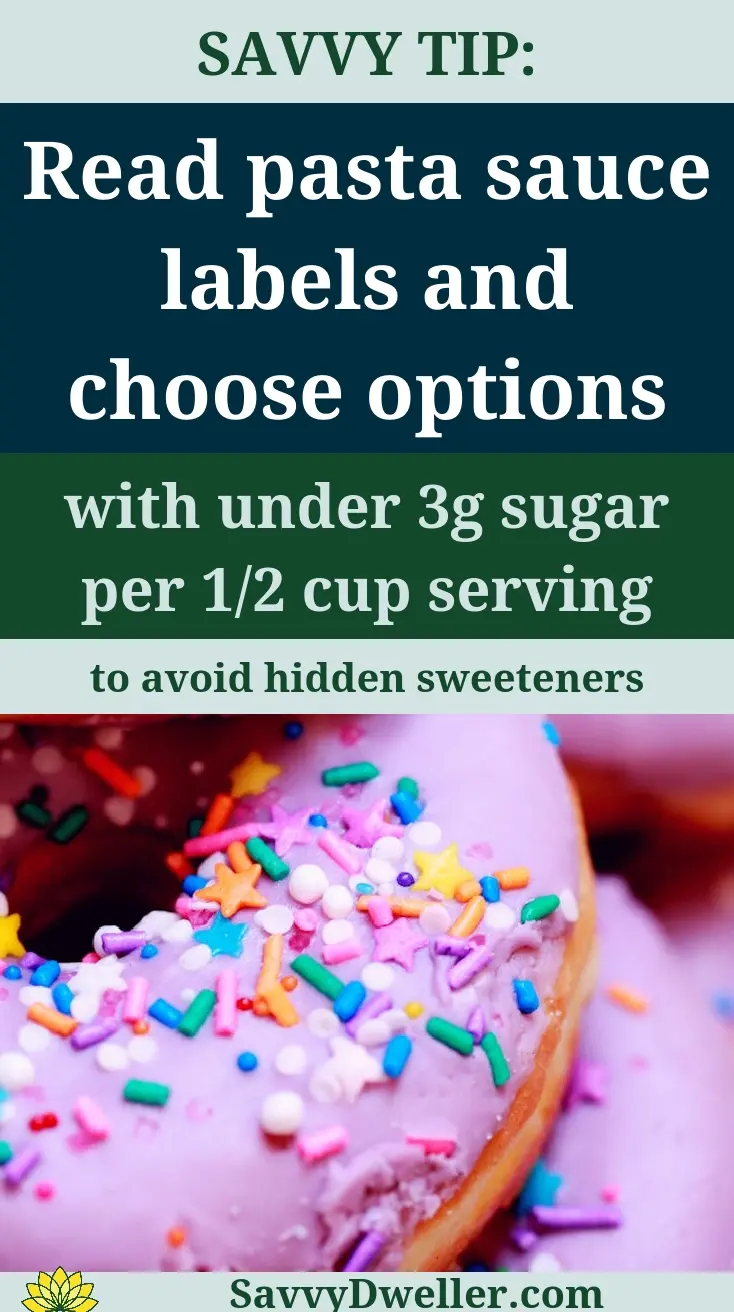
5 Habits to Keep Hidden Sugars From Sabotaging Your Health Goals
Master Label Reading in 30 Seconds
You don’t need a nutrition degree-just scan for these quick cues:
- Check “Added Sugars” under total carbs-aim for ≤4g per serving.
- Scan the ingredient list for aliases like maltose, dextrose, barley malt, or fruit juice concentrate.
- Compare similar products side-by-side-the one with fewer sweeteners wins.
Create a Sugar-smart Shopping List
Plan ahead to avoid impulse buys of surprising foods high in sugar. Focus your list on whole, single-ingredient items: fresh produce, plain legumes, unsweetened dairy, and unprocessed grains. When you pre-select clean staples, you naturally sidestep high sugar items hiding in plain sight. Incorporating foods that help manage blood sugar can enhance your grocery list even further. With the right choices, such as vegetables, nuts, and certain grains, it becomes easier to maintain healthy blood sugar levels.
Build Simple Meal Prep Routines
Dedicating just 90 minutes a week to basic prep slashes your reliance on packaged foods. Try this rotation:
- Roast two sheet pans of mixed veggies (e.g., carrots, zucchini, bell peppers).
- Cook a pot of plain beans or lentils for soups, salads, or sides.
- Make a big batch of broth-based soup using your own stock and frozen veggies.
Stock Your Pantry With Whole Food Alternatives
- Plain canned tomatoes (no sugar added)
- Dry lentils and beans
- Frozen vegetables without sauces
- Plain rolled oats
- Raw nuts and seeds
These staples let you recreate convenience foods-like tomato soup or granola-without the hidden sugar content in food.
Track Your Progress Without Obsessing
Instead of counting every gram, notice how you feel. When you reduce hidden sugars from ten surprising foods that are high in sugar, you’ll likely experience steadier energy, fewer cravings, and less afternoon fog. Use those shifts as your real-time feedback-not a spreadsheet.
Frequently Asked Questions
Is It Necessary to Completely Avoid Sugar to Be Healthy?
No, you don’t need to eliminate sugar entirely for good health. Moderation is the key principle. The focus should be on reducing added sugars, particularly hidden ones, while still enjoying natural sugars from whole foods like fruits and vegetables. Health experts often recommend that added sugars make up less than 10% of your daily calorie intake to support overall wellness.
For specific advice, prioritize whole fruits over processed options like fruit juices or sweetened dried fruits. When craving something sweet, opt for unsweetened versions of yogurt or oatmeal and add your own berries or a drizzle of honey in controlled amounts to satisfy your taste buds without overdoing it.
How Can I Identify Hidden Sugars Beyond Reading the Nutrition Label?
Look beyond the “Sugars” line on the nutrition facts panel by carefully scanning the ingredients list for sugar aliases. Common hidden names include sucrose, high-fructose corn syrup, maltose, dextrose, cane juice, or syrups. Also, be skeptical of products labeled “light,” “healthy,” or “natural,” as these can be marketing tricks for high-sugar items.
A practical tip is to choose foods with short, simple ingredient lists containing whole foods you recognize. For example, select nut butters with only nuts and salt, or make your own salad dressings with olive oil, vinegar, and herbs to avoid sneaky sweeteners found in many store-bought versions. Incorporating foods that naturally lower cholesterol can also be beneficial for heart health. Foods like oats, beans, and certain nuts not only keep your ingredient lists simple but also contribute to managing cholesterol levels effectively.
What Are the Immediate Signs That I’ve Consumed Too Much Sugar?
Shortly after eating high-sugar foods, you might experience a quick energy surge followed by a crash, increased cravings, or bloating. This rollercoaster effect occurs because sugar causes rapid spikes and drops in blood sugar levels, leading to fatigue, irritability, and sometimes headaches.
To manage this, pair sugary items with protein or fiber to slow sugar absorption. For instance, if you have a sweet snack, combine it with a handful of almonds or an apple to help maintain steady energy and reduce negative symptoms. Choosing foods with a low glycemic index can lead to more stable energy levels throughout the day, making it easier to avoid energy crashes.
Are Artificial Sweeteners a Safe Alternative to Sugar?
Artificial sweeteners are generally considered safe by health authorities when consumed in moderation, but they are not a perfect solution. While they provide sweetness without calories, some research suggests they might affect taste preferences or gut health over time. It’s wiser to focus on reducing overall sweetness intake.
For a healthier approach, gradually decrease sweetener use to retrain your palate toward less sweet flavors. If you need alternatives, consider natural options like stevia or monk fruit in small amounts, but emphasize whole, minimally processed foods to naturally curb sugar dependence. Adopting these habits can also contribute to reducing high triglyceride levels naturally. Focusing on whole foods and avoiding added sugars plays a crucial role in maintaining healthy triglyceride levels.
Also See: A Guide to the Best Plant-based Sources Of Protein
Final Words
You now have the knowledge to spot those sneaky sugar sources that have been hiding in plain sight. From your morning yogurt to that seemingly innocent pasta sauce, these ten foods demonstrate how easily added sugars slip into our daily routines. The good news is that small swaps can make a tremendous difference in supporting your wellness goals without sacrificing taste or convenience.
Start with just one or two changes this week – perhaps swapping flavored yogurt for plain Greek yogurt with berries, or making your own salad dressing. Your taste buds will adjust faster than you think, and you’ll likely notice improved energy levels and reduced sugar cravings within days. Remember, this isn’t about perfection; it’s about making informed choices that align with your health priorities.
Ready to transform more areas of your home and health routine? Check out Savvy Dwelling for more research-backed solutions that simplify healthy living. From kitchen hacks to wellness strategies, we’re here to help you create a home environment that supports your best life.

